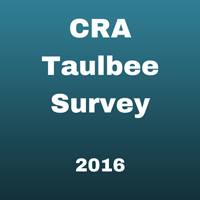2016 Taulbee Survey: Generation CS Continues to Produce Record Undergrad Enrollment; Graduate Degree Production Rises at both Master’s and Doctoral Levels
By Stuart Zweben and Betsy Bizot
The results from the 46th annual CRA Taulbee Survey are presented in this pdf. The survey, conducted annually by the Computing Research Association, documents trends in student enrollment, degree production, employment of graduates, and faculty salaries in academic units in the United States and Canada that grant the Ph.D. in computer science (CS), computer engineering (CE), or information (I). Most of these academic units are departments, but some are colleges or schools of information or computing. In this report, we will use the term “department” to refer to the unit offering the program.
The survey, conducted annually by the Computing Research Association, documents trends in student enrollment, degree production, employment of graduates, and faculty salaries in academic units in the United States and Canada that grant the Ph.D. in computer science (CS), computer engineering (CE), or information (I). Most of these academic units are departments, but some are colleges or schools of information or computing. In this report, we will use the term “department” to refer to the unit offering the program.
CRA gathers survey data during the fall. Responses received by February 17, 2017 are included in the analysis. The period covered by the data varies from table to table. Degree production and enrollment (Ph.D., Master’s, and Bachelor’s) refer to the previous academic year (2015-16). Data for new students in all categories refer to the current academic year (2016-17). Projected student production and information on faculty salaries are also for the current academic year; salaries are those effective January 1, 2017.
We surveyed a total of 268 Ph.D.-granting departments; we received salary responses from 173 and main survey responses from 168, for a total of 183 departments responding to one or both parts of the survey. The response rate was 68 percent, similar to last year’s 67 percent. The response rates from CE and Canadian departments continue to be rather low, and this year the CE response rate is the same as last year’s unusually low rate. U.S. CS, U.S. I, and Canadian response rates were similar to last year, with U.S. CS slightly up and Canadian slightly down. Figure 1 shows the history of the survey’s response rates. Response rates are inexact because some departments provide only partial data, and some institutions provide a single joint response for multiple departments. Thus, in some tables the number of departments shown as reporting will not equal the overall total number of respondents shown in Figure 1 for that category of department.
To account for the changes in response rate, we will comment not only on aggregate totals but also on averages per department reporting or data from those departments that responded to both 2015 and 2016 surveys. This is a more meaningful indication of the one-year changes affecting the data.
Departments that responded to the survey were sent preliminary results about faculty salaries in December 2016; these results included additional distributional information not contained in this report. The CRA Board views this as a benefit of participating in the survey.
Degree, enrollment, and faculty salary data for the U.S CS departments are stratified according to: a) whether the institution is public or private; and b) the tenure-track faculty size of the reporting department. The faculty size strata deliberately overlap, so that data from most departments affect multiple strata. This may be especially useful to departments near the boundary of one stratum. Salary data is also stratified according to the population of the locale in which the institution is located. These stratifications allow our readers to see multiple views of important data, and hopefully gain new insights from them. In addition to tabular presentations of data, we will use “box and whisker” diagrams to show medians, quartiles, and the range between the 10th and 90th percentile data points.
In this year’s survey, we made some modifications to the list of research areas for doctoral degree graduates in order to better reflect current areas of focus. We also began to collect enrollment data from certain key undergraduate CS courses, in a format similar to what was used in last year’s CRA Enrollment Survey, the results of which can be found at www.cra.org/cra/data/generation-cs. This will enable some ongoing tracking of enrollment changes at a finer level of detail than is now possible with the Taulbee Survey. Finally, this year we asked departments about their interest in getting additional data about the employment of teaching faculty as part of the survey. The responses will guide decisions that will be implemented in future Taulbee Surveys.
We thank all of the respondents to this year’s questionnaire. The participating departments are listed at the end of this article. CRA member respondents will again be given the opportunity to obtain certain survey information for a self-selected peer group. Instructions for doing this will be emailed to all such departments.


